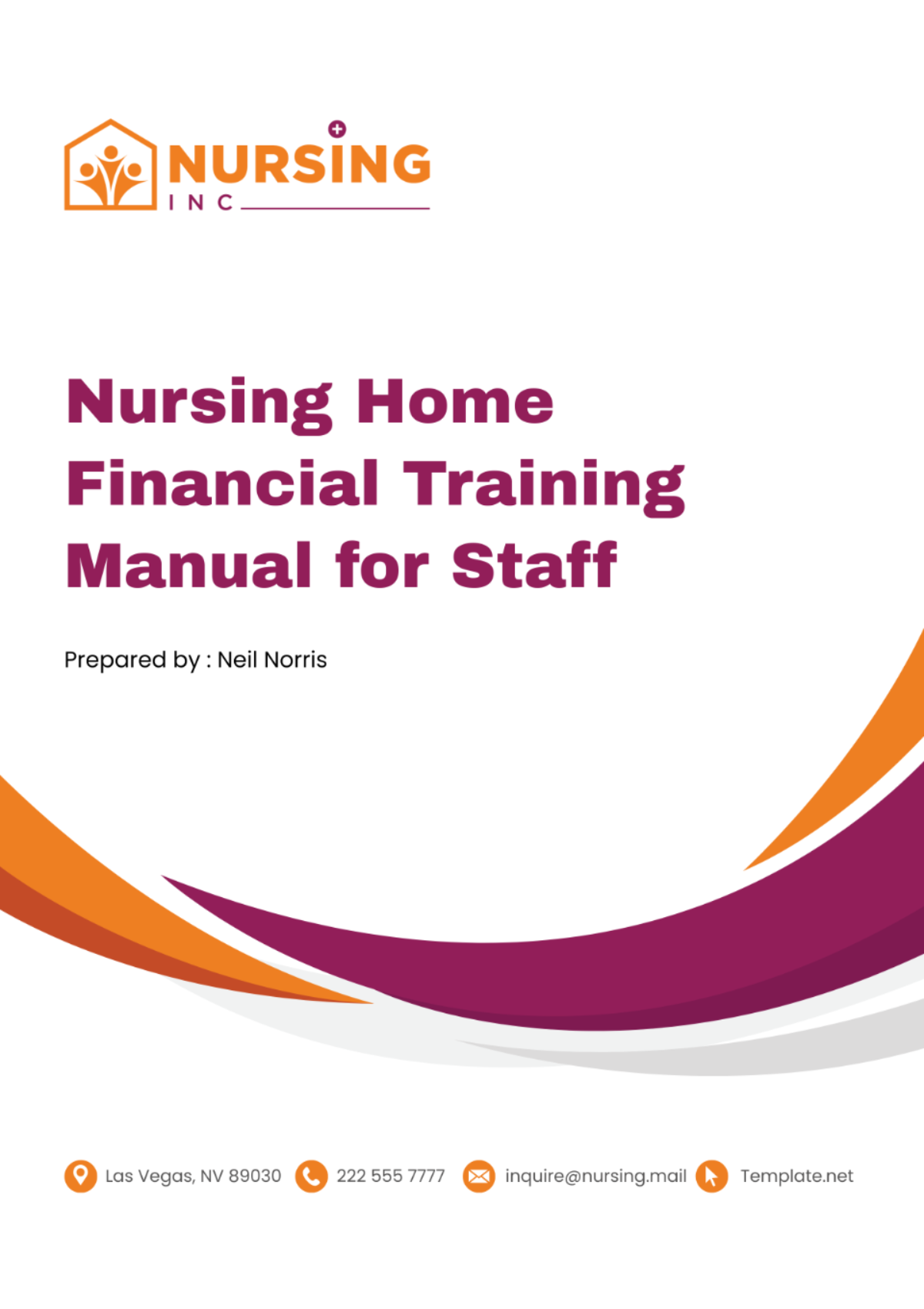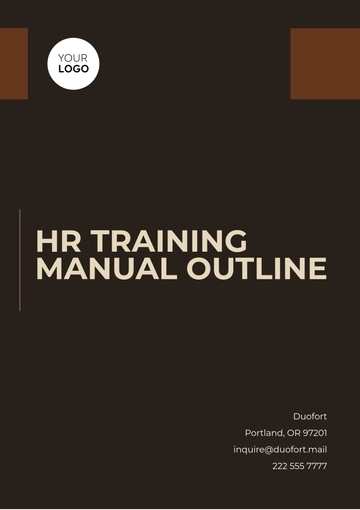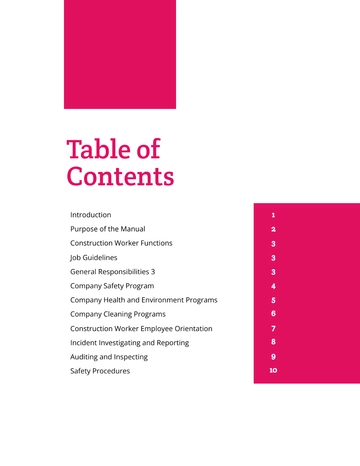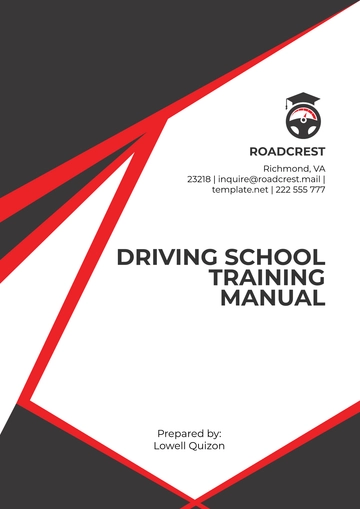Free Nursing Home Financial Training Manual for Staff

I. Introduction to Nursing Home Financial Training
A. Purpose of the Manual
The primary goal of this training manual is to equip nursing home staff with the knowledge and skills necessary to effectively manage financial aspects within the facility. By the end of this training, participants should be proficient in understanding financial concepts, budgeting, revenue generation, expense control, financial reporting, and compliance with regulatory requirements.
B. Importance of Financial Training for Nursing Home Staff
Financial management plays a critical role in the success and sustainability of nursing homes. Staff members, regardless of their specific roles, need to understand how their actions impact the financial health of the facility. Financial training empowers staff to make informed decisions, control costs, maximize revenue, and ensure compliance with regulatory standards. Moreover, it fosters a culture of accountability and efficiency, ultimately contributing to the delivery of high-quality care to residents.
C. Target Audience
Identification of Staff Roles Requiring Financial Training
Financial training is beneficial for all staff members working in nursing homes, including administrators, nurses, caregivers, billing specialists, dietary staff, maintenance personnel, and receptionists. Each role has a unique contribution to the financial operations of the facility, and therefore, all staff members should possess a basic understanding of financial principles relevant to their responsibilities.
Benefits of Financial Training for Different Staff Positions
Staff Position | Benefits of Financial Training |
|---|---|
Administrators | Enhanced ability to develop and manage budgets, analyze financial reports, and make strategic decisions. |
Nurses | Understanding of how nursing activities impact costs and revenues, leading to more efficient resource allocation. |
Caregivers | Awareness of the financial implications of resident care decisions, resulting in improved cost-effectiveness. |
Billing Specialists | Proficiency in accurate billing practices, reducing errors and maximizing reimbursement for services provided. |
Dietary Staff | Knowledge of cost-effective menu planning and inventory management to optimize food service operations. |
Maintenance Personnel | Appreciation of the cost-saving benefits of preventive maintenance and efficient use of facility resources. |
Receptionists | Understanding of the importance of timely and accurate documentation for billing and reimbursement purposes. |
II. Understanding Financial Basics
A. Introduction to Financial Concepts
Explanation of Basic Financial Terms
To ensure a common understanding, it's essential to define key financial terms used throughout this manual:
Revenue: The total income generated by the nursing home from providing services to residents, including payments from Medicare, Medicaid, private insurance, and self-pay residents.
Expenses: The costs incurred by the nursing home in the course of its operations, such as wages, utilities, supplies, and administrative expenses.
Profit: The difference between revenue and expenses, indicating the financial performance of the nursing home.
Income Statement: Also known as the profit and loss statement, it summarizes the revenue, expenses, and resulting profit or loss over a specific period.
Balance Sheet: A snapshot of the nursing home's financial position at a given point in time, showing its assets, liabilities, and equity.
Cash Flow Statement: Tracks the inflow and outflow of cash over a period, providing insights into the nursing home's liquidity and cash management.
Overview of Financial Statements
Nursing home staff must be familiar with the three primary financial statements:
Income Statement: This statement provides a summary of the nursing home's financial performance over a specific period, typically a month, quarter, or year. It shows the revenue earned, expenses incurred, and the resulting profit or loss.
Balance Sheet: The balance sheet presents the nursing home's financial position at a particular point in time, usually the end of a reporting period. It lists the organization's assets, liabilities, and equity, providing a snapshot of its financial health.
Cash Flow Statement: This statement tracks the inflow and outflow of cash during a specific period, categorizing cash flows into operating, investing, and financing activities. It helps assess the nursing home's ability to meet its short-term obligations and fund its operations.
B. Budgeting and Forecasting
Importance of Budgeting in a Nursing Home Setting
Budgeting is a crucial financial management tool that allows nursing homes to plan, monitor, and control their financial resources effectively. By creating a budget, nursing home administrators can allocate funds to different departments and activities, set performance targets, and measure actual performance against budgeted figures. Budgeting helps ensure financial stability, identify cost-saving opportunities, and prioritize spending to support resident care and operational needs.
Steps for Creating and Monitoring a Budget
Developing a comprehensive budget involves several key steps:
Assessment of Revenue Sources: Identify all sources of revenue, including Medicare, Medicaid, private pay, and other funding streams.
Estimation of Expenses: Estimate the costs associated with staffing, supplies, utilities, maintenance, and other operational expenses.
Setting Budget Targets: Based on revenue projections and expense estimates, set realistic budget targets for each department or cost category.
Monitoring and Adjusting: Regularly monitor actual financial performance against the budget, identify variances, and take corrective actions as needed to ensure financial targets are met.
Communication and Accountability: Communicate budget targets to relevant staff members, promote accountability for financial stewardship, and encourage collaboration in achieving budget objectives.
Review and Revision: Periodically review the budget to reflect changes in revenue, expenses, or operational priorities, and make necessary revisions to align with the nursing home's strategic goals.
III. Revenue Generation and Management
A. Sources of Revenue
Medicare and Medicaid Reimbursement
Medicare and Medicaid are primary sources of revenue for nursing homes, reimbursing facilities for providing eligible services to qualified beneficiaries. Medicare typically covers short-term skilled nursing care following a hospital stay, while Medicaid provides long-term care coverage for low-income individuals. It's essential for nursing home staff to understand the eligibility criteria, reimbursement rates, and documentation requirements for Medicare and Medicaid billing.
Private Pay and Insurance
Private pay residents and insurance coverage also contribute to nursing home revenue. Private pay residents directly pay for their care out-of-pocket, while insurance coverage may include long-term care insurance, supplemental health insurance, or managed care plans. Staff should be knowledgeable about insurance verification, claims submission, and coordination of benefits to maximize reimbursement from private payers.
Other Revenue Streams
In addition to government programs and private pay sources, nursing homes may generate revenue from other sources, such as:
Donations and charitable contributions from individuals, organizations, or foundations.
Grants and subsidies from government agencies or nonprofit organizations.
Ancillary services provided to residents, such as pharmacy services, therapy services, or beauty salon services.
Rental income from leasing out unused space within the facility.
Staff members should be aware of these alternative revenue streams and collaborate with management to explore additional opportunities for revenue generation.
B. Billing and Claims Processing
Billing Procedures for Different Payers
Nursing home staff must follow specific billing procedures and coding guidelines when submitting claims to different payers, including Medicare, Medicaid, private insurance companies, and self-pay residents. Each payer may have unique billing requirements, such as specific forms, codes, modifiers, and documentation criteria. Staff should receive training on proper billing practices and stay updated on changes in reimbursement rules and regulations.
Documentation Requirements for Accurate Claims Processing
Accurate documentation is critical for successful claims processing and reimbursement. Staff members responsible for documenting resident care should ensure completeness, accuracy, and compliance with regulatory standards. Key documentation elements include:
Resident assessments, care plans, and progress notes.
Medication administration records (MARs) and treatment records.
Physician orders, therapy notes, and discharge summaries.
Proper documentation not only supports billing claims but also ensures continuity of care and resident safety.
Strategies for Reducing Billing Errors and Denials
Billing errors and claim denials can result in delayed payments and revenue loss for nursing homes. To minimize errors and denials, staff should implement the following strategies:
Conduct regular audits of billing processes and documentation practices to identify areas for improvement.
Provide ongoing training and education to staff on coding guidelines, documentation requirements, and billing best practices.
Establish quality assurance protocols to review claims before submission and address any discrepancies or inaccuracies promptly.
Utilize electronic health record (EHR) systems and billing software with built-in error checking and validation features to improve accuracy and efficiency.
C. Resident Fee Management
Setting and Adjusting Resident Fees
Nursing homes must establish reasonable and competitive fee schedules for residents based on the level of care provided, facility amenities, and market conditions. Fee structures may vary depending on factors such as room type, level of care required, and additional services offered. Staff should work closely with management to review and adjust fee schedules periodically to reflect changes in operating costs, market trends, and resident preferences.
Handling Fee Collection and Delinquencies
Timely and accurate fee collection is essential for maintaining cash flow and financial stability. Staff responsible for fee collection should:
Communicate fee policies and payment expectations clearly to residents and their families upon admission.
Provide convenient payment options, such as online payment portals, automatic bank drafts, or payment plans, to facilitate timely payments.
Monitor accounts receivable regularly to identify overdue balances and follow up with residents or responsible parties to resolve delinquencies.
Implement policies and procedures for addressing outstanding balances, including late fees, payment arrangements, or referral to collections as necessary.
IV. Expense Control and Management
A. Understanding Nursing Home Expenses
Types of Expenses
Nursing home expenses encompass a wide range of categories, including:
Personnel costs, such as wages, salaries, benefits, and payroll taxes for staff members across various departments.
Operating expenses, including supplies, utilities, maintenance, repairs, equipment, and facility-related costs.
Administrative expenses, such as office supplies, professional services, insurance premiums, and regulatory compliance costs.
Depreciation and amortization expenses associated with the gradual wear and tear of assets and the allocation of intangible assets' costs over time.
Staff should understand the different expense categories and their significance in the overall financial performance of the nursing home.
Factors Influencing Expense Variability
Several factors can influence nursing home expenses and contribute to variability in spending, including:
Resident acuity levels and care needs, which may require additional staffing, supplies, or specialized services.
Fluctuations in occupancy rates and resident demographics, affecting revenue levels and demand for services.
Changes in regulatory requirements, reimbursement rates, and market conditions impacting operating costs and administrative burdens.
Investments in capital projects, technology upgrades, or facility improvements, resulting in one-time or recurring expenses.
Staff should analyze expense trends, identify cost drivers, and implement cost-saving measures to optimize resource allocation and operational efficiency.
V. Financial Reporting and Analysis
A. Interpretation of Financial Statements
Analyzing Income Statements for Profitability
The income statement, also known as the profit and loss statement, provides valuable insights into the nursing home's financial performance over a specific period. Staff should be able to interpret income statements to assess profitability and identify areas for improvement. Key elements of income statement analysis include:
Revenue Analysis: Evaluating revenue sources, trends, and variances against budgeted expectations or prior periods.
Expense Analysis: Analyzing expense categories, identifying cost-saving opportunities, and monitoring spending patterns.
Profitability Ratios: Calculating financial ratios such as gross profit margin, operating profit margin, and net profit margin to measure profitability relative to revenue.
By understanding the components of the income statement and analyzing financial ratios, staff can assess the nursing home's financial health and make informed decisions to enhance profitability.
Assessing Balance Sheets for Financial Health
The balance sheet provides a snapshot of the nursing home's financial position at a specific point in time, showing its assets, liabilities, and equity. Staff should be able to assess balance sheets to gauge the nursing home's financial health and solvency. Key aspects of balance sheet analysis include:
Asset Composition: Reviewing the composition and liquidity of assets, such as cash, accounts receivable, investments, property, and equipment.
Liability Management: Analyzing the types and amounts of liabilities, including accounts payable, accrued expenses, debt obligations, and deferred revenue.
Equity Position: Evaluating the nursing home's equity position, including retained earnings, capital contributions, and owner's equity.
By analyzing balance sheet components, staff can assess the nursing home's financial stability, liquidity, and leverage position, helping to inform strategic financial decisions.
Utilizing Cash Flow Statements for Liquidity Management
The cash flow statement tracks the inflow and outflow of cash during a specific period, categorizing cash flows into operating, investing, and financing activities. Staff should understand how to utilize cash flow statements to manage liquidity and cash flow effectively. Key aspects of cash flow statement analysis include:
Operating Activities: Analyzing cash flows from operating activities, including cash receipts from residents, payments to suppliers, and operating expenses.
Investing Activities: Assessing cash flows from investing activities, such as capital expenditures for facility improvements or investments in property and equipment.
Financing Activities: Reviewing cash flows from financing activities, including proceeds from loans, repayments of debt, and distributions to owners or investors.
By monitoring cash flows and analyzing trends in operating, investing, and financing activities, staff can assess the nursing home's ability to meet its short-term obligations, fund investments, and maintain financial stability.
B. Key Performance Indicators (KPIs)
Definition and Importance of KPIs in Financial Management
Key performance indicators (KPIs) are quantifiable metrics used to measure and evaluate the nursing home's financial performance, operational efficiency, and strategic objectives. Staff should understand the significance of KPIs in financial management and their role in driving continuous improvement. Key points regarding KPIs include:
Alignment with Strategic Goals: KPIs should be aligned with the nursing home's strategic objectives and reflect critical success factors for financial sustainability and resident care.
Measurement and Monitoring: KPIs should be measurable, relevant, and regularly monitored to track performance, identify trends, and make data-driven decisions.
Benchmarking and Comparison: KPIs can be used for benchmarking against industry standards, historical performance, or peer organizations to assess relative performance and identify areas for improvement.
By selecting and tracking relevant KPIs, staff can monitor financial performance, identify areas of strength and weakness, and implement targeted interventions to achieve organizational goals.
VI. Compliance and Regulatory Considerations
A. Overview of Regulatory Framework
Understanding Federal and State Regulations Affecting Nursing Home Finances
Nursing homes are subject to various federal and state regulations governing their financial operations, reimbursement policies, quality of care standards, and compliance requirements. Staff should have a solid understanding of the regulatory framework and its implications for financial management. Key areas of regulatory focus include:
Medicare and Medicaid Regulations: Compliance with Medicare and Medicaid regulations related to billing, documentation, reimbursement, and quality reporting requirements.
State Licensure and Certification: Adherence to state licensure and certification standards for nursing home operations, staffing levels, resident care, and facility infrastructure.
Financial Reporting Requirements: Compliance with federal and state financial reporting requirements, including submission of cost reports, audits, and financial disclosures.
B. Auditing and Internal Controls
Importance of Internal Controls in Financial Operations
Internal controls are policies, procedures, and mechanisms designed to safeguard assets, prevent fraud, ensure accuracy, and promote compliance with laws and regulations. Staff should understand the importance of internal controls in financial operations and their role in maintaining accountability and integrity. Key components of internal controls include:
Segregation of Duties: Assigning different responsibilities to multiple staff members to prevent errors or fraudulent activities.
Authorization and Approval Processes: Establishing procedures for authorizing transactions and approvals to ensure compliance with policies and regulations.
Documentation and Recordkeeping: Maintaining accurate and complete documentation of financial transactions, approvals, and decision-making processes.
Monitoring and Oversight: Implementing monitoring activities and periodic reviews to assess the effectiveness of internal controls and address deficiencies promptly.
VII. Case Studies and Practical Exercises
A. Real-Life Scenarios
Case Studies Illustrating Financial Challenges and Solutions in Nursing Homes
Case Study 1: Budget Variance Analysis
Scenario: A nursing home experiences significant budget variances in its staffing and supply expenses compared to the budgeted amounts.
Discussion Points:
Identify the root causes of budget variances.
Develop strategies to address excessive spending and improve cost control measures.
Explore opportunities for reallocating resources to areas of higher priority.
Case Study 2: Revenue Cycle Management
Scenario: A nursing home faces challenges with delayed reimbursements and increasing accounts receivable balances.
Discussion Points:
Analyze the revenue cycle process from resident admission to payment collection.
Identify bottlenecks and inefficiencies in billing and claims processing.
Implement measures to expedite reimbursement and reduce accounts receivable days.
Group Discussions and Analysis of Case Studies
Facilitate group discussions among staff members to analyze case studies, share insights, and brainstorm solutions to financial challenges. Encourage active participation, critical thinking, and collaboration to foster a deeper understanding of financial concepts and their practical applications in nursing home operations.
B. Practical Exercises
Hands-On Activities to Apply Financial Concepts Learned
Practical Exercise 1: Budget Preparation
Task: Work in teams to develop a monthly operating budget for a nursing home based on provided revenue and expense projections.
Objectives: Practice budgeting skills, prioritize spending, and allocate resources effectively to meet operational needs.
Practical Exercise 2: Financial Statement Analysis
Task: Analyze sample income statements and balance sheets to assess the financial health of a nursing home and identify areas for improvement.
Objectives: Interpret financial statements, calculate key financial ratios, and make recommendations for performance enhancement.
Role-Playing Exercises for Staff to Practice Billing and Budgeting Skills
Role-Playing Scenario 1: Billing and Claims Processing
Scenario: Assume roles as billing specialists, residents, and insurance representatives to simulate billing and claims processing interactions.
Objectives: Practice accurate coding, documentation, and claims submission processes to ensure timely reimbursement and minimize billing errors.
Role-Playing Scenario 2: Budget Negotiation
Scenario: Role-play negotiations between department heads and administrators to allocate budget resources for staffing, supplies, and capital expenditures.
Objectives: Enhance negotiation skills, advocate for departmental needs, and make data-driven budget decisions to optimize resource allocation.
- 100% Customizable, free editor
- Access 1 Million+ Templates, photo’s & graphics
- Download or share as a template
- Click and replace photos, graphics, text, backgrounds
- Resize, crop, AI write & more
- Access advanced editor
Empower staff with financial knowledge using the Nursing Home Financial Training Manual Template from Template.net. Editable and customizable, it provides comprehensive guidance on financial processes and management in nursing home facilities. Tailor it effortlessly using our Ai Editor Tool for personalized manuals. Ensure staff competency and efficiency with this essential template.





























